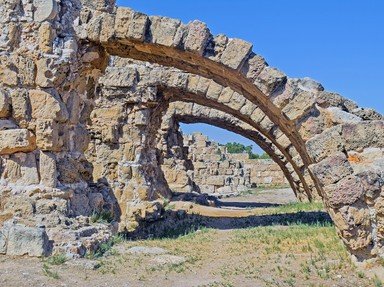Quiz Answer Key and Fun Facts
1. The stones used to build the Appian Way in the Roman Empire were large and irregular (the stones in this image have since been replaced). Upon completion, the road stretched from Rome far to the southeastern port city of Brindisi. Built during the Samnite Wars early in Roman history, what was the original purpose of the first section of the road built by its namesake, Roman censor Appius Claudius Caecus?
2. Connecting major cities to Edo (present-day Tokyo), the "Five Highways" allowed the leaders of feudal Japan to rule their country more efficiently. The most important route was the Tokaido, which connected Edo with Kyoto. Which group of powerful rulers (1600-1868) built this administrative road system?
3. Following footpaths along the base of the Rocky Mountains from Canada all the way to Mexico, the Blackfoot Indians of North America took the Old North Trail to carry trade goods or complete sacred missions. Later, they used dogs and horses to carry their cargo along this ancient road. What did the Blackfoot people call the Rocky Mountains that guided them along?
4. Ending in modern-day Cádiz, the Via Augusta was the busiest and most important road built by the Romans in which region?
5. Though much of it now lies beneath bitumen and concrete, the Great North Road in New South Wales, Australia, was built between 1825 and 1836 as a means to expand agricultural development. Which group of people was tasked with building this road?
6. The Wittmoor bog trackways in northern Hamburg, Germany, connected two sides of a swampy, inaccessible bog so that workers could cross them, though not without a bit of effort. They date to the 4th and 7th centuries AD. The two tracks were built by placing logs on top of mud and swampy land. What is this type of road known as?
7. The Inca were prolific road builders, creating a 40,000 km- (25,000 mi) road system that went from present-day Colombia all the way to Argentina. So many of their constructions still exist today including several stone pathways such as the one in the image. To which Inca site do these stone paths lead?
8. The Pilgrims' Way is a path that pilgrims took to the shrine of St. Thomas of Canterbury. Perhaps its most famous wayfarer was King Henry II, who took the path barefoot to the shrine out of atonement, eventually allowing a group of monks to whip him when he arrived. Why did he take this pilgrimage?
9. The Lechaion Road pictured here was built by the Romans in which Greek port city, the administrative capital of the Roman province of Achaea?
10. The phrase "all roads lead to Rome" feels very apt when researching ancient roads. Historians believe the phrase came about due to the Milliarium Aureum, or Golden Milestone, a Roman monument believed to have existed in the central Forum of Ancient Rome. The Milliarium Aureum was believed to have listed the distances to several cities under the control of the Roman Empire as illustrated here. All roads to these cities would lead back to this singular point. Which first emperor of the Roman Empire constructed it?
Source: Author
trident
This quiz was reviewed by FunTrivia editor
stedman before going online.
Any errors found in FunTrivia content are routinely corrected through our feedback system.
